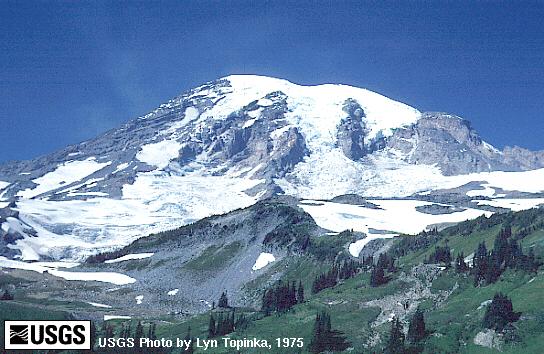|
Most volcanoes provide various types of warnings
before eruptions begin.
Although an explosive eruption could occur without warning, some
premonitory events more likely will precede the next eruption. Steam-blast
eruptions could occur with little or no warning as superheated water flashes to
steam; magmatic eruptions, however, involve rise of magma toward the surface.
Such an upward movement of magma normally will generate detectable earthquakes,
may deform the ground surface, and may cause anomalous heat flow or changes in
the temperature and chemistry of the ground and spring waters.
People living near volcanoes may detect premonitory events
before an eruption.
Both the frequency of occurrence and intensity of felt earthquakes commonly
increase before eruptions begin. Eruptions may also be preceded by noticeable
steaming or fumarolic activity and perhaps by new or enlarged areas of hot
ground. However, most precursory changes are subtle and the most effective
means of monitoring are instrumental and include a variety of geophysical,
geodetic, and geochemical techniques. Seismometers are used to detect and
locate earthquakes associated with the rise of magma. Swelling of the ground
surface can be detected by using precision instruments and techniques that
measure minute changes in slope, distance, or elevation at the ground surface.
Other techniques involve measurement of changes in heat flow at a volcano by
repeated infrared surveys or by direct measurements of hot spring or fumarole
temperatures. Changes in the composition or relative abundances of fumarolic
gases may also precede eruptions and can be detected by frequent or continuous
analysis of gases.
These and other types of monitoring may be useful in detecting warning signs of
impending eruption.
However, the overall success of a monitoring system depends on detection an
interpretation of precursory events in time to warn and evacuate people from
threatened areas and to initiate other measures to mitigate the effects of the
eruption. Although monitoring systems may be useful in indicating an increase
in the probability of volcanic activity and its possible location, they
typically do not indicate the kind or scale of an expected eruption,
particularly the first magmatic event, or the surrounding areas that might be
affected. Precursors to volcanic activity may continue for weeks, months, or
even years before eruptive activity begins, or they can subside at any time and
not be followed by an eruption. Thus, monitoring of volcanic precursors may
provide a general warning that volcanic activity in a specific area is becoming
more likely, but it often does not pinpoint the nature or timing of an eruption
or even its certainty.
-- Excerpts from:
C. D. Miller, 1989,
Potential Hazards from Future Volcanic Eruptions in California:
USGS Bulletin 1847
|



